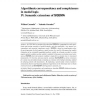31 search results - page 2 / 7 » Where the monotone pattern (mostly) rules |
JANCL
2008
13 years 6 months ago
2008
ABSTRACT. In [CON 06b] we introduced the algorithm SQEMA for computing first-order equivalents and proving canonicity of modal formulae, and thus established a very general corresp...
COLT
1992
Springer
13 years 10 months ago
1992
Springer
We consider learning in situations where the function used to classify examples may switch back and forth between a small number of different concepts during the course of learnin...
KDD
2000
ACM
13 years 9 months ago
2000
ACM
Higher quality synthesized speech is required for widespread use of text-to-speech (TTS) technology, and prosodic pattern is the key feature that makes synthetic speech sound unna...
ISCI
2007
13 years 6 months ago
2007
In this paper, we propose a novel spatial mining algorithm, called 9DLT-Miner, to mine the spatial association rules from an image database, where every image is represented by th...
AUSAI
2005
Springer
13 years 11 months ago
2005
Springer
Most data-mining techniques seek a single model that optimizes an objective function with respect to the data. In many real-world applications several models will equally optimize...

